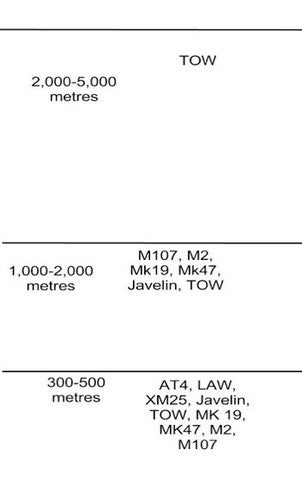[ This guest post was written by Charles Gaines ]
The last ten years of the US Army’s history has seen a refocus on the infantry and Special Operations communities as the main arms of warfare that hasn’t been seen since Vietnam. This is due to the asymetric nature of the wars in Afghanistan and Iraq and our increasing use of Special Forces diplomacy across the globe.
That being said, the Army has over the last forty years been developing increasingly robust infantry-centric antiarmour warfare capability. Whilst not intended to attack enemy armoured forces on their own, they do provide massive defensive firepower when employed with proper tactics and planning.
Below is a spreadsheet of US antiarmour-capable weapons and their effects against probable enemy armoured vehicles. I have focused on principally Russian vehicles, as there is still a lot of them floating around the globe and they will likely be familiar to readers.

Part I: Available weapons
1. M82A1 / M107

This is a weapon everyone is familiar with. Its antiarmour penetration is fairly marginal due to its inability to be fully compatible with the .50-cal Saboted Light Armour Penetrator round because of its muzzle brake. The muzzle brake on the M107 can be removed, but then you’re decreasing weapon accuracy and increasing recoil. The rifle is highly capable against civilian vehicles and BTRs (Soviet APCs).
2. M2/M2A1 heavy machine gun.

This is a highly capable weapon and a mainstay of the US Army. While the API round (Armor-Piercing Incendiary) only offers 16mm of penetration at 1200 meters, the SLAP round (Saboted Light Armor Penetrator) doubles that, with 34mm of penetration at the M2’s maximum effective range of about eighteen hundred meters. This is just enough to penetrate a BMP-2; the full-automatic fire capacity makes a kill very likely. There is also a special optics adapter for the M2 that maximizes effective range:
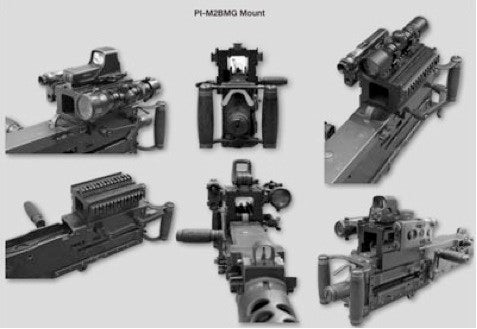
My old infantry battalion, 3-15 INF at Ft. Stewart GA, used these with the 6x ACOG and a PEQ-2 infrared laser.

3. Mk 19 grenade machine gun

The Mark 19 grenade machine gun is commonly found in the US Army’s light infantry battalions, along with the M2. It is significantly more capable against enemy armor than the latter, sporting a maximum effective range of 2200 meters and armor penetration of 50mm with its HEDP ammunition (High Explosive Dual Purpose). This renders it lethal against any Russian-produced armoured vehicle, including the BMP-2 and BMP-3, which sports a maximum of 35mm of armor. It is almost always either vehicle-mounted or placed in a prepared defensive position. The weapon and tripod weigh over a hundred pounds when assembled, making it a lethal but vehicle-dependent anti-armour weapon.
4. Mk 47 Grenade Machine Gun

The Mark 47 is a newer fully automatic grenade launcher. It is much lighter than the Mark 19, weighing 39 pounds as opposed to 77. It also has a capacity for airburst rounds, and the antiarmor round is the same HEDP as the Mk 19, offering the same 2200m range and 50mm armor penetration.
5. XM25

The XM25 is famous primarily for it’s High-Explosive Airburst Round which has been discussed on this blog before. The rest of the 25mm family of cartridges has not been similarly publicized however, and includes the XM1049 HEAT cartridge, which sports 50mm of armor penetration between 300 and 500m. This is a major game-changer. While it lacks the exceptional range of the M2, Mk19, and Mk47, it is a rifle that a single soldier can carry and utilize. When used in an ambushing role, the XM1049 round can defeat any of the listed infantry carrier vehicles, offering a multishot capability that the LAW and AT4 do not have, while weighing in the same category of fourteen or so pounds, and also possessing easily interchanged ammunition. The XM-25 has not been issued to the whole Army yet, but that will be changing. And when it does, IFV (Infantry Fighting Vehicle) tactics are going to be in need of serious modification.
6. M72 LAW
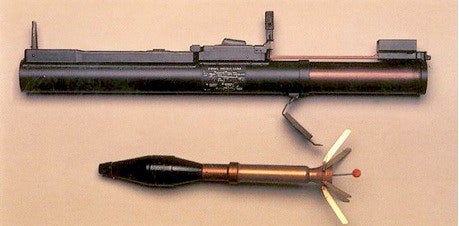
The M72 LAW is the oldest and least capable antitank rocket currently employed by the US Army. Its chief benefit is light weight; one or more LAWs can be fairly easily carried by a single soldier. It is capable of defeating most infantry vehicles’ armor, but is marginal against moving or obscured targets due to being unguided. It has seen a rebirth in recent years with newer generation warheads such as the blast/fragmentation warhead to be used against enemy infantry.
7. AT/M136
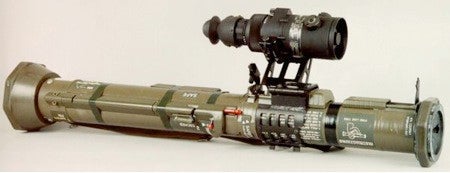
The AT4 was selected in the 1980s to replace the LAW as it possessed a far superior armor penetrator than the M72. With between 420-600mm of armor penetration it can destroy anything short of the tanks on the above list. It might even defeat tanks if a top-attack angle is available, such as from a multi-storey building to a tank on the street below. Like the LAW it has limited ability against moving or obscured targets. While it is capable of having optics mounted, as seen in the picture above, it is intended to be disposable, which means you’ll be wasting time recovering the expensive optic from your disposable antitank weapon upon use. The AT-4 has a maximum effective range of 300m for a point target, or 500 meters for an area target.
8. Javelin

The Javelin ATGM is a ground-breaking weapon. It’s first use in combat was probably in 2003 at the Battle of Debecka Pass, where US Special Forces and Kurdish Peshmerga guerrilla engaged a force of eight armoured personnel carriers and four T-55 tanks. At least four of the APCs were destroyed by Javelin missiles. The Javelin was the first man-portable fire and forget antitank weapon. It uses an imaging infrared seeker to track the selected target. The Command Launch Unit and missile tube weigh just under 40 pounds.

The Command Launch Unit includes a daytime 12x scope and a nighttime/bad weather infrared optic. It can be used independently of the missile/tube; which is disposable upon firing. The Javelin has a maximum effective range of approximately 2,000 meters.
9. TOW

The BGM-71 TOW is the heaviest antiarmor missile operated by ground forces in the US Army. It is always vehicle-mounted, and can be found on the M2/3 Bradley, Stryker ATGM vehicle and selected uparmored Humvees, as seen above, and below:

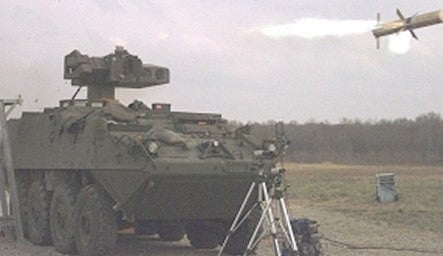
There are no fewer than nine TOW missile variants. The most recent variant is the TOW-RF, which unlike older models is not wire-guided and so has its range boosted to 4,500 metres as a result, as opposed to the A through H models’ range of 3,750 metres. It is not a true fire-and-forget weapon, however it’s exceptional range compensates for that quite well. A properly camouflaged Stryker or Humvee with these on board is a potent threat to enemy armor.
Part II: Maximizing effects
All of the above weapons can be found in a US Army infantry battalion. They offer complimentary effects, and a “system of systems” allowing engagement from point blank range to 4.5 kilometers:
Clearly, engaging with just your heaviest (and therefore least numerous) weapons at the maximum achievable range is not advisable. Infantry tactics rely on shock effect and using terrain and maneuver to achieve advantage.

This might look like an ideal environment for antitank warfare, it most definitely is not. Tanks and other armoured vehicles typically have excellent long-range optical sensors; this is why they are well-suited to plains and deserts. Engaging armoured units in this kind of environment is extremely hazardous, and given the relatively limited firepower available, a bad idea. Ideal terrain for an antiarmor ambush limits the vehicle’s mobility, situational awareness, and firepower. An example would be:

Here, we have an almost perfect example of terrain ideal to killing armoured vehicles. The vehicles will be going slowly do to driving uphill to begin with, and also can’t directly see around the loop; the loop itself is going to require them to go even more slowly. They are also trapped on the road; the grades are probably too high for them to go offroad. In contrast, infantry with Javelin ATGMs can occupy the high ground and see for miles; when they attack, it will be from very close range, where a tank’s situational awareness is poorest, and lethality of their weapons will be at its greatest. A competent tank commander would do his utmost to keep his vehicles out of places like this unless he has helicopters and infantry supporting him.
The best place for infantry to confront armored vehicles is this:

There is tons of cover. Vehicle situational awareness is extremely poor, and their firepower advantages are largely nullified. More importantly, unlike terrain, cities cannot be bypassed-they ultimately must be taken. Urban centers offer other advantages to infantry, such as the easy creation of chokepoints to force vehicles into ambush zones, and ready-made structures to maneuver from or fall back to; there is literally nothing advantageous about cities for armoured vehicles.
Ideally, an infantry company with attached heavy weapons platoon could set up an ambush like so:
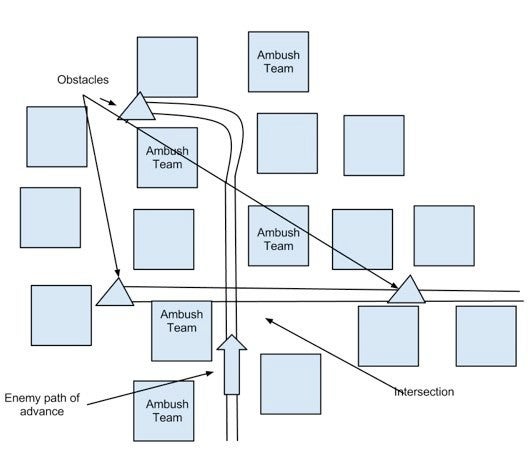
-
All ambush teams have both interlocking fields of fire, and additional buildings to fall back to.
-
Obstacles are used, but are out of sight to enemy vehicle crews.
-
Area is built-up to minimize vehicle speed and situational awareness.
These are the basics to a successful ambush of enemy armour in urban terrain. Other considerations could include bait-a bridge or similar high-value object that the enemy needs to take, or combining your long-range weapons on the edge of the city to both score kills and lure the enemy inside your ambush.
I don’t really have much else to say about this; other topics of interest for readers might be the Line Of Sight Antitank missile program, or the Compact Kinetic Energy Missile program.
 Your Privacy Choices
Your Privacy Choices

